Computer vision, once limited to static image recognition, has rapidly evolved thanks to the integration of Artificial Intelligence (AI). What started as a tool for basic pattern recognition is now a cornerstone of advanced systems that interpret, analyze, and respond to visual data in real time. As AI continues to improve in terms of deep learning, neural networks, and contextual understanding, it’s pushing the AI in computer vision industry from simple automation to true augmented intelligence—where machines not only see but also understand and make decisions based on what they observe.
The AI-Driven Transformation of Computer Vision
Artificial Intelligence enhances computer vision by enabling machines to learn from data rather than rely on explicit programming. Deep learning algorithms, particularly convolutional neural networks (CNNs), have become the backbone of AI in computer vision, making it possible to identify objects, detect anomalies, and even read emotions with remarkable accuracy.
This AI-driven transformation is facilitating a shift from rule-based automation to dynamic decision-making, where systems continuously learn and adapt. From predictive maintenance in factories to autonomous vehicles on roads, computer vision powered by AI is redefining how machines interact with the world.
Key Applications Fueling Growth
1. Smart Surveillance and Security
AI-powered computer vision is revolutionizing surveillance with real-time threat detection, facial recognition, and behavioral analysis. Modern security systems can now identify unusual patterns—such as loitering or crowd formation—and alert authorities without human oversight, increasing both response speed and accuracy.
2. Healthcare Diagnostics
In medical imaging, AI-driven computer vision can detect tumors, fractures, and other anomalies that may be missed by the human eye. Technologies like AI-enhanced MRI and CT scans are enabling earlier diagnoses and more personalized treatment plans, especially in oncology, radiology, and ophthalmology.
3. Industrial Automation
In manufacturing, AI-based vision systems are streamlining quality control, defect detection, and assembly line monitoring. Machines equipped with intelligent vision can adjust processes in real time, leading to higher productivity, lower error rates, and reduced waste.
Download PDF Brochure @
https://www.marketsandmarkets.com/pdfdownloadNew.asp?id=141658064

4. Autonomous Vehicles and Transportation
Self-driving cars are one of the most high-profile applications of AI and computer vision. These systems rely on real-time visual data to make split-second decisions on navigation, obstacle detection, and traffic interpretation, playing a critical role in vehicle safety and performance.
5. Retail and Customer Insights
In retail, computer vision is used for shopper analytics, inventory management, and cashier-less checkout systems. AI interprets visual cues to determine customer engagement, monitor product movement, and automate reordering—enhancing both customer experience and operational efficiency.
From Automation to Augmented Intelligence
The true potential of AI in computer vision lies in its ability to augment human intelligence rather than replace it. This involves combining the speed and precision of machines with human intuition and contextual understanding. In scenarios like surgery, quality control, and security monitoring, AI acts as a co-pilot—enhancing decision-making rather than taking full control.
Such augmented intelligence opens up new possibilities in fields where absolute autonomy may not be desirable or possible. For example, AI can assist doctors with diagnostic suggestions or guide technicians in real-time during equipment repairs, offering supportive rather than fully autonomous interventions.
Challenges to Overcome
Despite rapid progress, the journey from automation to augmented intelligence in computer vision isn’t without challenges:
-
Data Privacy and Ethics: Widespread surveillance and biometric recognition raise privacy concerns that must be addressed with strong regulations and transparent AI practices.
-
Bias and Accuracy: AI systems can inherit bias from training datasets, leading to skewed outcomes—especially in facial recognition or law enforcement applications.
-
Infrastructure Needs: High-performance computer vision requires advanced hardware, massive datasets, and seamless integration with cloud or edge computing—posing technical and financial barriers.
Future Outlook: A Vision Beyond Vision
As AI algorithms become more sophisticated and datasets grow richer, we can expect computer vision systems to evolve from passive observers into active collaborators. Future innovations may include:
-
Explainable AI (XAI) that makes computer vision decisions transparent and interpretable.
-
Edge AI deployment, allowing vision systems to operate efficiently on local devices with minimal latency.
-
Cross-domain learning, where AI learns from one application (like medical imaging) and applies insights to another (such as industrial inspection).
Ultimately, the fusion of AI and computer vision will lead to systems that not only perceive the world but understand it in nuanced ways, enabling safer, smarter, and more responsive technologies.
Conclusion: Seeing Smarter with AI
The future of computer vision lies not in replacing humans, but in enhancing human potential through intelligent visual systems. As AI continues to mature, it will unlock capabilities that transcend automation, leading us into an era of augmented intelligence—where machines don’t just see, but truly comprehend and collaborate. Industries that embrace this transition will gain a competitive edge, reshaping how we interact with the world and with each other.
